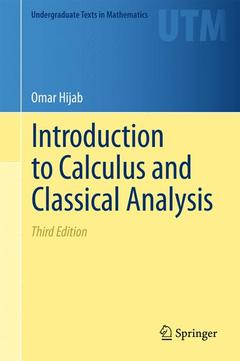Description
Introduction to Calculus and Classical Analysis (3rd Ed., Softcover reprint of hardcover 3rd ed. 2011)
Undergraduate Texts in Mathematics Series
Author: Hijab Omar
Language: English
Subject for Introduction to Calculus and Classical Analysis:
Keywords
Calculus; Classical analysis; Continuity; Differentiation; Integration; combinatorics
Publication date: 04-2013
364 p. · 15.5x23.5 cm · Paperback
Approximative price 60.08 €
Subject to availability at the publisher.
Add to cartPublication date: 06-2007
· 15.5x23.5 cm · Hardback
Description
/li>Contents
/li>Comment
/li>
This text is intended for an honors calculus course or for an introduction to analysis. Involving rigorous analysis, computational dexterity, and a breadth of applications, it is ideal for undergraduate majors. This third edition includes corrections as well as some additional material.
Some features of the text include: The text is completely self-contained and starts with the real number axioms; The integral is defined as the area under the graph, while the area is defined for every subset of the plane; There is a heavy emphasis on computational problems, from the high-school quadratic formula to the formula for the derivative of the zeta function at zero; There are applications from many parts of analysis, e.g., convexity, the Cantor set, continued fractions, the AGM, the theta and zeta functions, transcendental numbers, the Bessel and gamma functions, and many more; Traditionally transcendentally presented material, such as infinite products, the Bernoulli series, and the zeta functional equation, is developed over the reals; and There are 385 problems with all the solutions at the back of the text.
1 The Set of Real Numbers.- 1.1 Sets and Mappings.- 1.2 The Set R.- 1.3 The Subset N and the Principle of Induction.- 1.4 The Completeness Property.- 1.5 Sequences and Limits.- 1.6 Nonnegative Series and Decimal Expansions.- 1.7 Signed Series and Cauchy Sequences.- 2 Continuity.- 2.1 Compactness.- 2.2 Continuous Limits.- 2.3 Continuous Functions.- 3 Differentiation.- 3.1 Derivatives.- 3.2 Mapping Properties.- 3.3 Graphing Techniques.- 3.4 Power Series.- 3.5 Trigonometry.- 3.6 Primitives.- 4 Integration.- 4.1 The Cantor Set.- 4.2 Area.- 4.3 The Integral.- 4.4 The Fundamental Theorem of Calculus.- 4.5 The Method of Exhaustion.- 5 Applications.- 5.1 Euler’s Gamma Function.- 5.2 The Number π.- 5.3 Gauss’ Arithmetic-Geometric Mean (AGM).- 5.4 The Gaussian Integral.- 5.5 Stirling’s Approximation of n!.- 5.6 Infinite Products.- 5.7 Jacobi’s Theta Functions.- 5.8 Riemann’s Zeta Function.- 5.9 The Euler–Maclaurin Formula.- A Solutions.- A.1 Solutions to chapter 1 .- A.2 Solutions to chapter 2.- A.3 Solutions to chapter 3.- A.4 Solutions to chapter 4.- A.5 Solutions to chapter 5.- References.- Index
Approaches calculus and introductory analysis in a nonstandard way
New edition extensively revised and updated
Completely self-contained text
Includes supplementary material: sn.pub/extras



